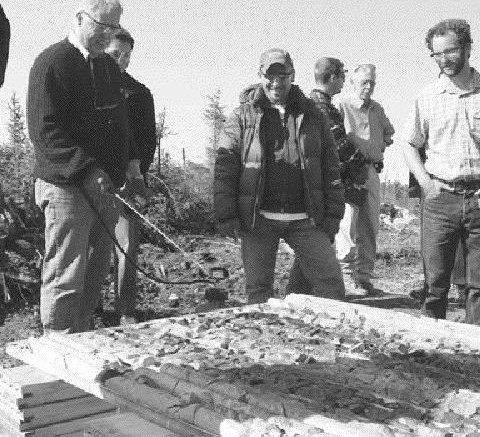Success in drilling new mineralization at the Matoush uranium prospect in the Otish basin of Quebec has drawn a number of junior companies eager to try and find a lookalike in the Proterozoic sedimentary rocks of the Otish Group.
While the area is not blanketed with claims like Saskatchewan’s Athabasca basin, several juniors have picked up ground either to test known uranium showings or to block out favourable geology.
What has served notice that the Otish basin is a potential uranium area is the program by Strateco Resources (RSC-V, SRSIF-O) on the Matoush property, discovered by Uranerz in the late 1970s and orphaned by the low uranium prices of the 1980s. Drilling in early 2006 around Uranerz’s discovery hole established that the prospect had some continuity, and Strateco has been trying to delineate the zone since.
This season’s winter drilling returned further high-grade intersections on the property’s AM-15 zone, the main mineralization discovered by Uranerz and expanded by Strateco. Eight holes on the zone in December 2006 all intersected some uranium mineralization.
Most of the intersections were 1 to 5 metres long, and U3O8 grades ranged from 0.1% to 0.6%. Among the better results were a 5.5-metre length grading 1.66% U3O8 and a 15.2-metre intersection that ran 2.13%.
All the holes intersected the Matoush fault, a structure that appears to control the mineralization.
Three of five exploration holes drilled north of the AM-15 zone intersected low uranium concentrations, but two holes cut significant grades; one ran 0.05% U3O8 over 0.8 metre and another 0.2% U3O8 over 1.5 metres.
Among the juniors that have followed Strateco into the area, Consolidated Pacific Bay Minerals (CBP-V, CPBMF-O) has one of the more advanced programs, having contracted for an airborne geophysical survey jointly with Strateco. Pacific Bay’s part of the survey covered ground surrounding Strateco’s Matoush property and another property about 15 km west, Southwest Otish, where Pacific Bay has staked the unconformity on the southwest corner of the Otish Basin.
The airborne magnetic, radiometric and electromagnetic survey revealed a dominant northeast-trending structural fabric, plus a set of more subtle north-trending features that appear to be parallel to the Matoush fault. Pacific Bay is following up on those with magnetic and very low frequency electromagnetic surveys on the ground, to map the structures in more detail.
A drill was to be mobilized before the Eastmain winter road closes for the season.
Joint-venture partners Melkior Resources (MKR-V, MKRIF-O) and Santoy Resources (SAN-V, SANRF-O) have assembled a land position in the area, starting with 113 sq. km staked by Melkior and 211 sq. km contributed by Santoy.
The partners bought an outright interest in the Marc-Andre property, about 15 km northeast of the Strateco prospect, from privately held International Royalties for $10,000 cash, 200,000 shares of Melkior, and 40,000 shares of Santoy. Melkior director Lee Barker is the original vendor of the property, and retains a 2% royalty.
The partners’ other acquisition was an option deal with Majescor Resources (MAJ-V) on a 147-sq.-km property in the same Lac Laparre area, about 25 km northeast of Matoush. They must spend $2.5 million on exploration over five years, with at least $300,000 of that in the first year of the agreement. Majescor keeps a one-third interest, a 1.5% net smelter return, and all rights to diamond mineralization, and gets $50,000 cash, 200,000 shares of Melkior and 40,000 shares of Santoy.
Trenching at Marc-Andre in the 1980s, also by Uranerz, exposed uranium mineralization on the contact of a gabbro dyke. There is a boulder train in the southwest part of the property next to a suspected fault zone.
Golden Valley Mines (GZZ-V, GLVMF-O) and Lexam Explorations (LEX-V, LEXEF-O) have concluded a deal where Lexam finances Golden Valley’s work on its property northwest of the Strateco ground. Lexam has committed to a $3-million program over three years to earn a 50% stake in the property.
Golden Valley’s ground wraps northeast along the edge of the Otish Group sediments where they are in contact with the underlying Archean basement, a setting like that of many of the early discoveries in the Athabasca and Thelon basins. Initially the partners plan airborne geophysical surveys, followed by ground geophysics, mapping and prospecting.


Be the first to comment on "Strateco’s hits attract juniors to Otish"